The Shiseido Gallery, which opened its doors in 1919, is said to be the oldest art gallery still operating in Japan. In the years since, it has pursued its non-profit activities nearly continuously, closing only occasionally due to earthquakes, war, reconstructions, and other vicissitudes, always dedicated to the ideal of "discovering and creating new value." To date, the Shiseido Gallery has hosted over 3,100 exhibitions, many of which served as the public debut for burgeoning artists who would later make major contributions to the course of Japanese art.
In the 1990s the Gallery shifted its emphasis to contemporary art and began a dynamic program aimed at introducing the expression of that era, noted for combining vanguard contemporaneity with a sense of simple purity.
In 2001 the Gallery facilities were relocated to the underground level of the Tokyo Ginza Shiseido Building. This space includes a five-meter ceiling that makes it the tallest exhibition hall in the Ginza district, a feature which has caught the attention of both Japanese and foreign artists for the expressive possibilities it opens up as an exhibition venue.
Introducing the Shiseido Gallery
A History of the Shiseido Gallery
1919
On 13 December, An exhibition space that would become the Shiseido Gallery is established on the second floor of Shiseido’s cosmetics shop located at Takekawa-cho 11 (now Ginza 7-8-10).
Shinzo Fukuhara
Third son of Shiseido founder Arinobu Fukuhara, and later Shiseido’s first president.
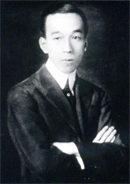
Near the end of 1919 (or perhaps January 1920), artists pose in the newly created exhibition space. These included Settai Komura, Nobutatsu (Roso) Fukuhara (front row, from right); Seiji Ikumi, Shinzo Fukuhara, Kyota Mizuki and Riichiro Kawashima (middle row, from right); and Nobuyoshi Fukuhara, Seika Suekawa and Makoto Ishii (back row, from right). Kawashima would later be part of Shiseido’s Tsubaki-kai artists exhibition group.

Shiseido Cosmetics Division
In 1916, Kingo Tatsuno (Tatsuno & Kasai Architectural Office) did the planning for this three-story brick and ferroconcrete building. In 1923 it was damaged significantly during the Great Kanto Earthquake, and in 1926 it was demolished to make way for the construction of a new headquarters building.

1923
Shiseido’s buildings are devastated by the Great Kanto Earthquake on September 1, but the company moves quickly to recover. By November it has constructed a temporary but usable gallery using the building’s remaining brick shell, and exhibits resume.
1924
The name is changed to “Shiseido Bijutsu Bu” (“Shiseido Art Division”)
1926
In preparation to rebuild the headquarters after the earthquake, the Shiseido Art Division moves temporarily to the second floor of Miyazawa Construction’s Ginza location.
1928
In May, the construction on a new Shiseido Cosmetics Division building (designed by Kenjiro Maeda) at Takekawa-cho 11 is completed. The second floor of this building becomes the “Shiseido Gallery,” a dedicated exhibition space, and is soon being used for such activities (later, the third-floor hall would also be used). Each year, the new gallery would host several solo and group exhibitions. Major Western-style painters like Ryuzaburo Umehara and Riichiro Kawashima opened the First Shiseido Art Exhibition (which ran until 1931), the genesis of the later Tsubaki-kai artists exhibition group.
Shiseido Cosmetics Division
Construction is completed in 1928 on this ferroconcrete building designed by Kenjiro Maeda. It included one floor below ground and three stories above ground, with one portion extending to four stories. The second floor was set aside as a true gallery space. This building was demolished in 1973 to make way for the construction of the Shiseido The Ginza Building.
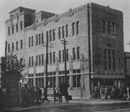
A 1934 photo of the second floor of the Cosmetics Division in the building designed by Kenjiro Maeda.

A hand railing and stained glass in the Shiseido Gallery.
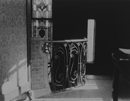
1932
The Shiseido Gallery becomes busy as up-and-coming artists like Kyujin Yamamoto and Kunitaro Suda stage their first solo exhibitions.
1933
In April, the First Seiko-kai Exhibition
Front row, from right: Sotaro Yasui, Kokei Kobayashi, and Ryuzaburo Umehara.
Back row, from right: Shintaro Goto, unknown, Yukihiko Yasuda, and Bakusen Tsuchida.
The Seiko-kai Exhibition, organized by Shintaro Goto, was one of the Shiseido Gallery’s most popular exhibitions in the pre-war period. The eight founding members included the six artists pictured here, plus Hanjiro Sakamoto and Chozan Sano. The Seiko-kai would exhibit often through 1954. Several members including Yasui, Kobayashi, Umehara, Yasuda, and Sakamoto would go on to participate in the Tsubaki-kai as well.
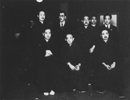
1937
In April, the Rokushoku-kai Crafts Exhibition
From right: Takeo Unno, Junichiro Yoshida, Ken Miyanohara, Masahiko Katori, Kozo Kagami, Taiji Tamura, and Baiju Itaya. These seven members, who had formerly participated in the Teiten crafts exhibitions, formed the newcomers group Rokushoku-kai, featuring craft works in metal, ceramics, glass, and mosaic work. A journal kept by Ken Miyanohara contained the entry: “15 April. Clear, then cloudy, then rain. First Rokushoku-kai exhibition. Very successful, our membership very happy with the results, and speaking for myself, very motivating… Met Marquis Hosokawa for the first time. Sold one incense burner.” From this we can see that the Shiseido Gallery served as a place where as-yet-unknown young artists were presented with important opportunities to come in contact with visitors from the higher echelons of society.

1939
Despite the specter of war, young artists continue to form a variety of smaller groups, and the number of exhibitions increases dramatically over the next several years (seventy-two in 1939, eighty-two in 1940, eighty-five in 1941, ninety-six in 1942, ninety in 1943, and eighty in 1944).
In December 1940, The First Japanese Etching Exhibition
From right: Unknown, Takeharu Sogao, Itaru Tanabe, Ko Sasaki, Takeo Nishida, Junzo Kon, unknown, Tetsuro Komai, Minoru Kasaki, Koshi Ota, and Yoshiyuki Matsuda.
At the time of this photo, Tetsuro Komai was still a twenty year-old art student, but in 1953 holds his first solo show at the Shiseido Gallery.

1941
With the start of the Pacific War, it becomes increasingly difficult for Shiseido to continue operating, since its products do not contribute to the war industry. But even while other galleries are shuttering their doors, the Shiseido Gallery remains open, hosting a total of 270 exhibitions up until eight months before the end of hostilities in August 1945.
In July 1941, First Issai-sha Exhibition
From right: Tatsuo Takayama, Masao Urata, Noboru Okada, and Seiji Nojima.
The Issai-sha was formed by four young Japanese-style painters who had formerly been members of the Rusoga-sha group that disbanded in 1938. Takayama would go on to participate in the Tsubaki-kai.
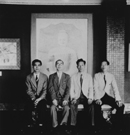
In October 1941, Settai Komura Posthumous Exhibition
From right: Hakuun Tasaka, Yasuji Toita, Takeo Yamamoto, three people skipped, Yae Komura (Settai’s wife), unknown, Ton Satomi, Mantaro Kubota, and Genshiro Shima. Settai Komura (also known as Taisuke Yasunami) was a member of Shiseido’s design department (the progenitor of todays promotions division) from 1918 to 1923, where he worked under Shinzo Fukuhara creating posters and other promotional materials. This posthumous exhibition showing his illustrations and performing arts was held by Shiseido a year after his death.

1943
The Shiseido Gallery changes its name to “Shiseido Garo,” part of a wartime nationalistic trend to eliminate foreign loanwords (like “gallery”) from the Japanese language.
1944
In December, The war intensifies, and the Shiseido Garo is forced to close its doors.
1947
The gallery re-opens, changing its name back to “Shiseido Gallery.” The first incarnation of the Tsubaki-kai artists exhibition group is inaugurated, including Taikan Yokoyama, Yasushi Sugiyama, Ryuzaburo Umehara, Sotaro Yasui, and Tsuguharu Foujita. This first group would continue exhibiting through 1954.
1950
First Mayumi-kai Western-Style Painting Exhibition (ran until 1968)
While the Tsubaki-kai featured some of Japan’s most prestigious painters, the Mayumi-kai orchestrated by Atsuo Imaizumi was comprised of lesser known artists, including Kazu Wakita, Kaoru Yamaguchi, Noriyuki Ushijima, and Minoru Kawabata.
1963
The Shiseido Cosmetics Division opens another gallery space on its third floor, bringing in Atsuo Imaizumi and Yoshiro Taniguchi as advisors. The Second Tsubaki-kai (ran until 1966) begins, this time featuring artists like Shinsen Tokuoka and Ryuzaburo Umehara. Also, the First Rengyo-kai Exhibition is held (ran until 1968), with a selection committee including Kotaro Takamura Sculpture Prize winners like Yoshitatsu Yanagihara and Yoshi Kinouchi.
In February 1964, A photo from the Artists Atelier Series (1), taken in the atelier of Shikanosuke Oka (far left). Oka also participated in the Tsubaki-kai. The Artists Atelier Series held fifteen exhibitions, ending with Chikkyo Ono’s Atelier in 1975.

In March 1964, A photo from the Artists Atelier Series (2), taken in the atelier of Yasushi Sugiyama (far left). Sugiyama also participated in the Tsubaki-kai.

1971
The Shiseido Gallery is closed temporarily during the construction of the Shiseido The Ginza Building.
1974
A new gallery is constructed on the ninth floor of the Shiseido Parlor Building, and the Third Tsubaki-kai begins (ran through 1990) with participating artists including Togyu Okumura and Shikanosuke Oka.
Construction is completed on the Shiseido Kaikan (later renamed the Shiseido Parlor Building, located at Ginza 8-8-3) in 1962. Designed by Yoshiro Taniguchi, this ferroconcrete construction had one basement level and nine stories above ground. It was renovated completely in 1973. In 1997 it was demolished to make way for the construction of the new Tokyo Ginza Shiseido Building.
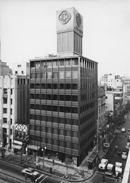
1975
The Exhibition of Contemporary Crafts begins in December, with participation by craftsmen like Kazuo Yagi and Shoji Kamoda. This exhibition would be held twenty times through 1995, becoming a pillar of the Shiseido Gallery’s exhibition activities.
Construction is completed on the Shiseido The Ginza Building (located at Ginza 7-8-10) in 1975. Designed by Yoshinobu Ashihara, this ferroconcrete construction had two basement levels and eight stories above ground. The fifth floor was devoted to The Ginza Hall, a space used intermittently to Shiseido-sponsored special exhibitions. In 1985, the basement level one was converted into The Ginza Art Space, used as a gallery, but also for exhibitions of non-mainstream outsider art, subculture art, and so on (through 2000).
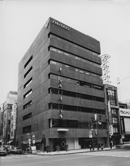
In 1978, the two-story ferroconcrete building housing the Shiseido Art House (in Kakegawa, Shizuoka) is constructed, designed through a collaboration between Yoshio Taniguchi and Shinsuke Takamiya. This building houses Shiseido’s art collection, historical promotional materials, and other artifacts from Shiseido’s history, and presents these to the public through a variety of exhibitions. In 1979 it won the AIJ Prize (sponsored by the Architectural Institute of Japan).
Click here to link to the Shiseido Art House website

1990
Shiseido establishes a Corporate Culture Department.
1991
As the first installment of its “Shiseido Gallery & Its Artists” exhibition series, the Shiseido Gallery sponsors the exhibition “Tetsuro Komai Retrospective: Copperplate Etchings 15 Years after the Poet’s Passing” (ran through 1995).
1992
In September, Shiseido inaugurates the “Shiseido Gallery introducing Japanese Artists Living in Abroad,” a special exhibition featuring the work of Japanese artists residing abroad, conducted in collaboration with the Cartier Foundation for Contemporary Art. Solo exhibitions by artists like Mariko Mori, Jun Nguyen-Hatsushiba, and others (ran for eight shows through 1995).
1992
The Shiseido Art House in Kakegawa, Shizuoka. This museum collects and houses Shiseido products, promotional materials, and other artifacts, and exhibits a portion of these to the public.
Click here to link to the Shiseido Corporate Museum website

1993
The Fourth Tsubaki-kai (ran through 1997) begins, featuring artists Masakazu Horiuti, Gyoji Nomiyama and others.
1994
East Asian Modern Artists Exhibition — Promenade in Asia begins. Participating artists include Cai Guo-Qiang, Wu Mali, Wen-Zhou, and Ideal Copy.
1995
Seventy-Five Years of the Shiseido Gallery: 1919–1994 is published.
1997
The second East Asian Modern Artists Exhibition — Promenade in Asia holds. Participating artists included Cai Guo-Qiang, Huang Yong Ping, Suh Do-Ho, Kim Bum, Yutaka Sone, Zhou Tiehai, and Choi Jeong Hwa. In June, the gallery was temporarily closed due to construction on the Tokyo Ginza Shiseido Building.
2001
The Fifth Tsubaki-kai begins (ran through 2005) featuring Toeko Tatsuno, Noe Aoki, and others. In August, the third East Asian Modern Artists Exhibition — Promenade in Asia holds. Participating artists included Huang Rui, Rong Rong, Chung Seoyoung, Chu Chia-Hua, and Atsushi Hosoma.
2001
The Tokyo Shiseido Ginza Building (located at Ginza 8-8-3) is completed, designed by Ricardo Bofill. The Shiseido Gallery is reconstructed in the basement level.
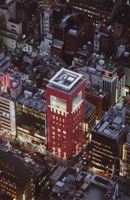
2004
HOUSE OF SHISEIDO (Head office at NAMIKI street) opened in 2004.
HOUSE OF SHISEIDO closed on 31st March in 2011 due to reconstruction of Shiseido Head office.

2006
The public exhibition shiseido art egg begins.
2007
Celebrating the sixtieth anniversary of the Tsubaki-kai’s founding, the Sixth Tsubaki-kai begins (ran through 2010), with participating artists including Yasuko Iba, Chiharu Shiota, Masanori Sukenari, Kyotaro Hakamata, Naofumi Maruyama, and Miwa Yanagi.
Shiseido receives a “Grand Mécénat Award” for its operation of the Shiseido Gallery at the “Mécénat Awards 2007” sponsored by the Association for Corporate Support of the Arts.
2009
The Shiseido Gallery celebrates its ninetieth year. Commemorative activities include special panel discussions and dialogs on the theme of “The Power Engendered by Art.”
• The Origin of Creativity, featuring sculptor Katsura Funakoshi and dancer Ushio Amagatsu.
• Photos & Images, featuring photographer Rinko Kawauchi and artist Tabaimo.
• Asia & Contemporary Art, featuring Hervé Chandès (director of the Cartier Foundation for Contemporary Art) and independent curator Fei Dawai.
• The Possibilities of Architecture, featuring architect Junya Ishigami and physicist Shoichi Yamada, moderated by architect and architecture historian Taro Igarashi.
2013
The Seventh Tsubaki-kai series begins a run that will last through 2017, featuring Genpei Akasegawa, Naoya Hatakeyama, Rei Naito, Zon Ito, and Ryoko Aoki. These will be joined in 2015 by Yasutake Shimaji, the first dance artist to participate in the Tsubaki-kai.
2014
Shiseido receives a “Flower Art Award” for its support of the Tsubaki-kai, the Shiseido Gallery, and the Shiseido Art House at the “Mécénat Awards 2014” sponsored by the Association for Corporate Support of the Arts.
2016
Shiseido takes 3rd place at the Italian “Corporate Art Awards® 2016” for its active corporate efforts to contribute to artistic culture.
Tenth anniversary of the “shiseido art egg”.
2017
The Tsubaki-kai celebrates the 70th anniversary of its establishment.